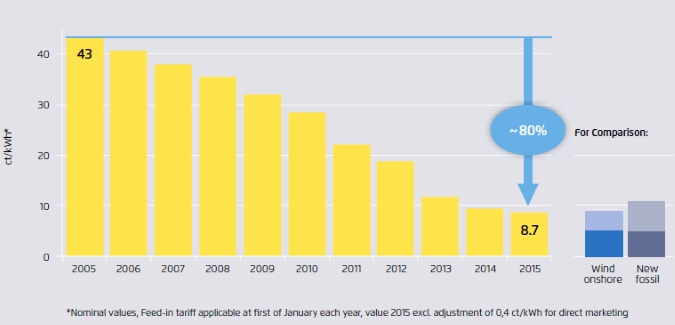Solar to be cheapest source of energy in next 10 years
LONDON: Solar will be the cheapest form of electricity in many regions of the world in the next 10 years, a new report states.
The Current and Future Cost of Photovoltaics by the institute Fraunhofer ISE on behalf of Agora Energiewende forecasts how falling prices of solar photovoltaics will affect the future of the low carbon energy, because “there’s no end to the cost decline in photovoltaics”, according to Dr Patrick Graichen, CEO, Agora Energiewende.
The report shapes long-term scenarios for solar market development, system prices and costs of energy from utility-scale systems. Solar costs are already low, with power prices from large-scale photovoltaic installations in Germany falling about 80{9926b46fcb7237b8e0c952280a6e921869d40a91ad32927528e9646374b80fe0}, from over €0.43/kilowatt-hour (kWh) in 2005 to €0.09/kWh in 2014.
But because solar power requires a high up-front investment and then gives almost ‘free’ power for a long time, the report warns that “financial and regulatory environments will be key for reducing costs in the future”.
“Everyone, poor or rich, understands what adds real value to their lives. And the people we meet are convinced solar power is an investment worth making; an investment that will enhance the standard of their lives,” saysKrishnan Pallassana, India Director, The Climate Group. “Our solar Bijli project in India for example, has brought in multiple benefits, most importantly to enhance productivity and thus create a social revolution. Bijli has proven that market driven, off-grid solar solutions actually empower people. Solar energy is waiting to explode as a big league business in India – a promise that begs deliverance.”

Image: Feed-in tariff for new large-scale solar photovoltaic in Germany, courtesy of Agora Energiewende
GLOBAL SOLAR REVOLUTION
Solar prices are dropping all around the world. But in India, where Prime Minister Narendra Modi has launched aNational Solar Mission, prices have fallen 61{9926b46fcb7237b8e0c952280a6e921869d40a91ad32927528e9646374b80fe0} in just three years – so that power generation from solar plants in the country is now cheaper than indigenous or imported coal.
At the same time, a power purchase agreement for a 200 MW-solar farm in Dubai was recently signed for €0.05/kWh, and many other projects under construction in Brazil, Uruguay and other countries are set to produce solar energy at costs below €0.07/kWh.

Image: Historical development of installed PV capacity worldwide, courtesy of Agora Energiewende
Historically, the price of solar follows the ‘photovoltaic (PV) learning curve’ – the trend that with each duplication in the total number of modules produced, the price per module falls by roughly 20{9926b46fcb7237b8e0c952280a6e921869d40a91ad32927528e9646374b80fe0}.
Even with a conservative approach and considering the “very pessimistic scenario”, global PV module costs still decrease from about €550/kW today to €270-€360/kW-peak by 2050 – and €140-€210/kWp in the “breakthrough” scenario. ‘Solar inverter’ technology will follow suit, requiring just €23-€39/kWp by 2050 instead of €110/kWp today.
In Europe in particular, solar power costs are expected to reach €0.04-€0.06/kWh by 2025 and €0.02–€0.04/kWh by 2050 – a decrease of one-third and two-third respectively.

Image: Cost of electricity from new solar power plants in Southern and Central Europe, courtesy of Agora Energiewende
But it is in India, the Middle East and North Africa where solar will demonstrate most potential. The report states in these regions solar will reach a cost of €0.16-€0.37/kWh by 2050. In North America the price range will vary due to the geographical differences between its different regions, from €0.15-€0.58/kWh in 2050. This is similar to Australia, with a cost of €0.16-€0.49/kWh.
Importantly though, this study only focuses on conventional silicon-based solar technologies and ground-mounted systems – excluding rooftop solar systems and promising new technologies like ‘concentrating’ photovoltaics. So while the economic case looks clear, more work is needed to discover the full potential of solar power.





